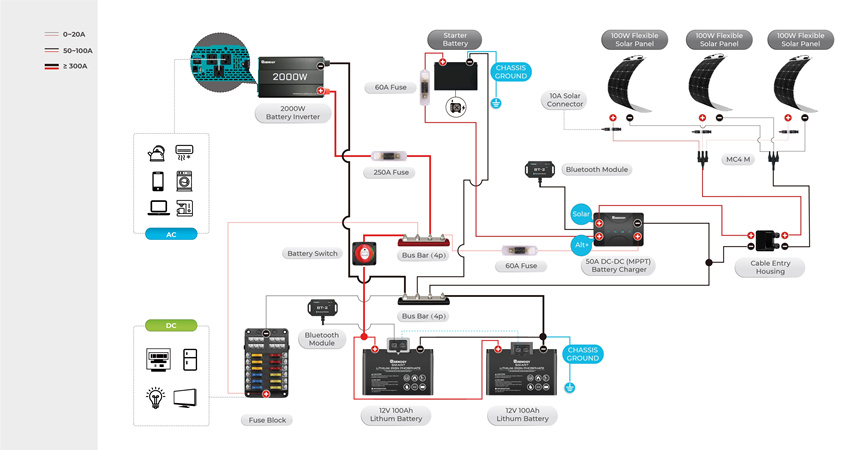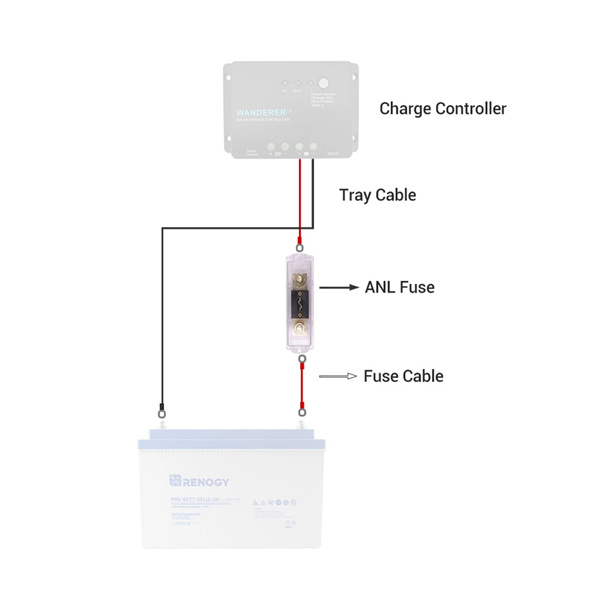How to Fuse your Solar System
By Stephen Clifton
Technical Representative

The picture above is an electrical wiring diagram for RV and you may notice that fuses and circuits are included.
What is the purpose of a fuse?
When hooking up your Renogy system, the best way to add protection is by using fuses or circuit breakers. Fuses and circuit breakers are used to protect the wiring from getting too hot and also protect all devices connected in the system from catching fire or getting damaged if a short circuit occurs. They are not necessary for the system to run properly, but we always recommend using fuses or circuit breakers for safety purposes.
How to Fuse your Solar System?
There are three different locations that we recommend installing fuses or breakers.
First, between the charge controller and battery bank, second, between the charge controller and solar panels, and third would be between the battery bank and inverter.

How to size the fuse?
To determine the fuse size needed between the charge controller and battery bank you simply match the amperage rating on the charge controller. For instance, if you have one of our 40Amp charge controllers, we would recommend using an 40Amp fuse.
The second fuse between your solar panels and charge controller is a little bit different to figure out. The size of this fuse is dependent on how many solar panels you have and how they are connected (series, parallel, or series/parallel). If the panels are connected in series, the voltage of each panel is added but the amperage stays the same. For example, if you have four 100W panels connected in series, each producing 20 volts and 5 amps, the total output would be 80 volts and 5 amps. We then take the total amperage and multiply it by a safety factor of 25% (5A x 1.25) giving us the fuse rating of 6.25A or 10A if we round up. If you have a parallel connection, where the amperage of the panels is added up but the voltage stays the same, you would have to add up the amperage of each panel and then we add a 25% industry rule to figure out the fuse size. For example, if you had four 100W panels hooked in a parallel connection, each panel produces about 5 Amps, so we would use this equation (4 * 5 * 1.25) = 28.75 Amps, so in this instance we would recommend a 30 Amp fuse.
The last fuse that we recommend in the system would be if you are using an inverter. This fuse would be between your inverter and the battery bank. The fuse size is usually stated in the manual and most inverters already have built in fuses/breakers. The rule of thumb that we use here would be “Continuous Watts / Battery Voltage times 1.25, for example a typical 1000W 12V inverter draws up around 83 continuous amps and we would add the 25% safety factor which comes out to 105 Amps, so we would recommend a 150A fuse.
This is a brief introduction and summary for fusing your system. There are other aspects such as cable size/length and fuse/breaker types that are important. We recommend giving us a call for more information!
Related articles:
How Much Power Does A 4.5 KW Solar System Produce?
RV Types: Choosing The Right RV Classification For Your Needs
How Long Does It Take To Install Solar Panels: 2023 Guide
How Many KWh Does A House Use Per Day: Ultimate Guide
Important Things You Should Know When Buying A House With Solar Panels








